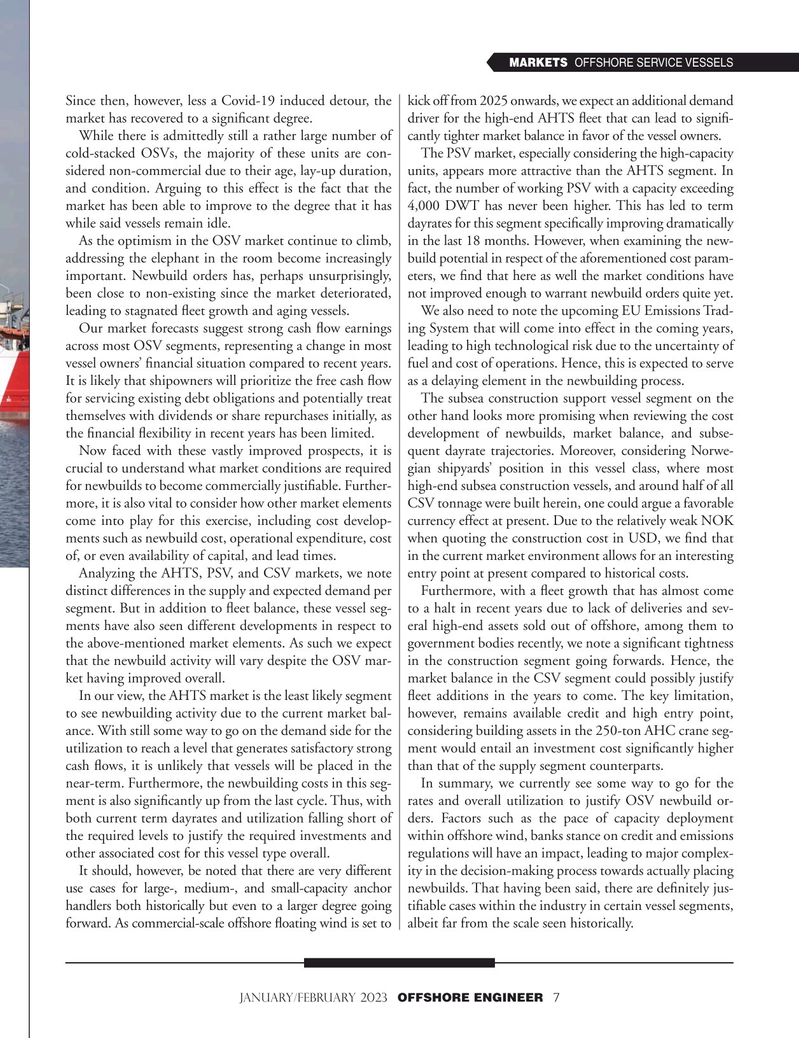
Page 7: of Offshore Engineer Magazine (Jan/Feb 2023)
Read this page in Pdf, Flash or Html5 edition of Jan/Feb 2023 Offshore Engineer Magazine
MARKETS OFFSHORE SERVICE VESSELS
Since then, however, less a Covid-19 induced detour, the kick off from 2025 onwards, we expect an additional demand market has recovered to a signi?cant degree. driver for the high-end AHTS ?eet that can lead to signi?-
While there is admittedly still a rather large number of cantly tighter market balance in favor of the vessel owners.
cold-stacked OSVs, the majority of these units are con- The PSV market, especially considering the high-capacity sidered non-commercial due to their age, lay-up duration, units, appears more attractive than the AHTS segment. In and condition. Arguing to this effect is the fact that the fact, the number of working PSV with a capacity exceeding market has been able to improve to the degree that it has 4,000 DWT has never been higher. This has led to term while said vessels remain idle. dayrates for this segment speci?cally improving dramatically
As the optimism in the OSV market continue to climb, in the last 18 months. However, when examining the new- addressing the elephant in the room become increasingly build potential in respect of the aforementioned cost param- important. Newbuild orders has, perhaps unsurprisingly, eters, we ?nd that here as well the market conditions have been close to non-existing since the market deteriorated, not improved enough to warrant newbuild orders quite yet. leading to stagnated ?eet growth and aging vessels. We also need to note the upcoming EU Emissions Trad-
Our market forecasts suggest strong cash ?ow earnings ing System that will come into effect in the coming years, across most OSV segments, representing a change in most leading to high technological risk due to the uncertainty of vessel owners’ ?nancial situation compared to recent years. fuel and cost of operations. Hence, this is expected to serve
It is likely that shipowners will prioritize the free cash ?ow as a delaying element in the newbuilding process. for servicing existing debt obligations and potentially treat The subsea construction support vessel segment on the themselves with dividends or share repurchases initially, as other hand looks more promising when reviewing the cost the ?nancial ?exibility in recent years has been limited. development of newbuilds, market balance, and subse-
Now faced with these vastly improved prospects, it is quent dayrate trajectories. Moreover, considering Norwe- crucial to understand what market conditions are required gian shipyards’ position in this vessel class, where most for newbuilds to become commercially justi?able. Further- high-end subsea construction vessels, and around half of all more, it is also vital to consider how other market elements CSV tonnage were built herein, one could argue a favorable come into play for this exercise, including cost develop- currency effect at present. Due to the relatively weak NOK ments such as newbuild cost, operational expenditure, cost when quoting the construction cost in USD, we ?nd that of, or even availability of capital, and lead times. in the current market environment allows for an interesting
Analyzing the AHTS, PSV, and CSV markets, we note entry point at present compared to historical costs.
distinct differences in the supply and expected demand per Furthermore, with a ?eet growth that has almost come segment. But in addition to ?eet balance, these vessel seg- to a halt in recent years due to lack of deliveries and sev- ments have also seen different developments in respect to eral high-end assets sold out of offshore, among them to the above-mentioned market elements. As such we expect government bodies recently, we note a signi?cant tightness that the newbuild activity will vary despite the OSV mar- in the construction segment going forwards. Hence, the ket having improved overall. market balance in the CSV segment could possibly justify
In our view, the AHTS market is the least likely segment ?eet additions in the years to come. The key limitation, to see newbuilding activity due to the current market bal- however, remains available credit and high entry point, ance. With still some way to go on the demand side for the considering building assets in the 250-ton AHC crane seg- utilization to reach a level that generates satisfactory strong ment would entail an investment cost signi?cantly higher cash ?ows, it is unlikely that vessels will be placed in the than that of the supply segment counterparts. near-term. Furthermore, the newbuilding costs in this seg- In summary, we currently see some way to go for the ment is also signi?cantly up from the last cycle. Thus, with rates and overall utilization to justify OSV newbuild or- both current term dayrates and utilization falling short of ders. Factors such as the pace of capacity deployment the required levels to justify the required investments and within offshore wind, banks stance on credit and emissions other associated cost for this vessel type overall. regulations will have an impact, leading to major complex-
It should, however, be noted that there are very different ity in the decision-making process towards actually placing use cases for large-, medium-, and small-capacity anchor newbuilds. That having been said, there are de?nitely jus- handlers both historically but even to a larger degree going ti?able cases within the industry in certain vessel segments, forward. As commercial-scale offshore ?oating wind is set to albeit far from the scale seen historically.
january/february 2023 OFFSHORE ENGINEER 7

 6
6

 8
8